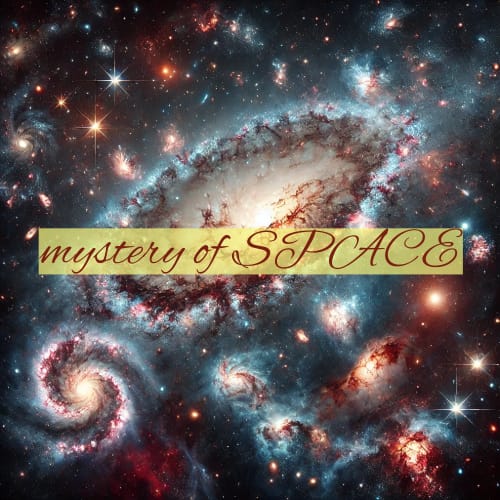Space, the vast expanse beyond Earth’s atmosphere, is the ultimate frontier that has captivated humanity for centuries. It holds countless mysteries about the universe, its origins, and its future. As scientific exploration has advanced, our understanding of space has expanded, revealing fascinating details about planets, stars, galaxies, black holes, and even the possibility of extraterrestrial life.
1. What is Space?
Space refers to the seemingly infinite, mostly empty, and cold vacuum that exists beyond Earth’s atmosphere. It is where celestial bodies like planets, stars, moons, and asteroids reside. While the exact boundary between Earth’s atmosphere and space is debated, most scientists agree that the Kármán Line, at 100 kilometers (62 miles) above sea level, serves as the dividing point.
Space itself is not completely empty; it contains low-density particles, cosmic rays, and electromagnetic radiation, including light from stars and galaxies. The vast distances between objects in space are measured in light years, which is the distance light travels in one year—about 9.46 trillion kilometers.
2. Components of Space
There are many elements within space, each contributing to the greater structure of the universe:
• Galaxies: These are massive collections of stars, dust, and dark matter, bound together by gravity. Our galaxy, the Milky Way, is one of billions in the universe.
• Stars: Stars are massive, luminous spheres of plasma, undergoing nuclear fusion. The Sun is a star and provides energy that sustains life on Earth.
• Planets and Moons: Planets are large celestial bodies orbiting stars, while moons orbit planets. Earth is part of the Solar System, which consists of eight planets.
• Asteroids, Comets, and Meteoroids: These small celestial bodies orbit the Sun. Asteroids are rocky, while comets are icy, and meteoroids are fragments that can enter Earth’s atmosphere, becoming meteors.
3. The Big Bang and the Universe’s Origin
The prevailing theory for the universe’s origin is the Big Bang, which suggests that approximately 13.8 billion years ago, the universe began as an incredibly hot and dense point. Since then, it has been expanding, and this expansion is still happening today. The cosmic microwave background radiation is evidence of the Big Bang, representing leftover heat from the early universe.
4. Space Exploration
Humanity has made remarkable strides in space exploration since the launch of Sputnik 1, the first artificial satellite, by the Soviet Union in 1957. Key milestones in space exploration include:
• Moon Landing: In 1969, NASA’s Apollo 11 mission saw Neil Armstrong become the first human to walk on the Moon.
• International Space Station (ISS): Launched in 1998, the ISS serves as a collaborative platform for scientific research and has hosted astronauts from various countries.
• Mars Exploration: Several missions, including NASA’s Perseverance Rover, aim to explore Mars for signs of past or present life and understand the planet’s environment.
5. Black Holes and Dark Matter
• Black Holes: These are regions in space where gravity is so strong that nothing, not even light, can escape. They form from the remnants of massive stars after they collapse. In 2019, scientists captured the first image of a black hole, located in the galaxy M87.
• Dark Matter and Dark Energy: These invisible forms of matter and energy make up most of the universe’s mass. Dark matter doesn’t emit light but exerts gravitational forces, while dark energy is thought to be responsible for the universe’s accelerated expansion.
6. Human Spaceflight and Colonization
Space agencies like NASA, SpaceX, and Blue Origin are working toward enabling humans to live beyond Earth. SpaceX’s Starship aims to carry humans to Mars, with the long-term goal of establishing a self-sustaining human colony. This raises questions about the challenges of human spaceflight, such as:
• Radiation: Space travelers are exposed to high levels of radiation, which can increase cancer risk.
• Microgravity: Prolonged exposure to microgravity affects muscle mass, bone density, and cardiovascular health.
• Life Support: Sustaining life in space requires technology to provide air, water, and food.
7. The Role of Satellites
Satellites play a critical role in modern life. Communication satellites enable global communication networks, while Earth observation satellites monitor weather patterns, natural disasters, and environmental changes. GPS satellites allow for precise navigation across the planet.
8. The Future of Space Exploration
Looking ahead, space exploration will continue to focus on discovering more about our solar system, other galaxies, and the universe itself. Ambitious goals include:
• Mars Colonization: Companies like SpaceX aim to establish human settlements on Mars by the 2030s, with the goal of making humanity a multi-planetary species.
• Asteroid Mining: Companies are researching the feasibility of mining asteroids for valuable resources, such as water and rare metals, that could support space travel and economic growth.
• Search for Extraterrestrial Life: Missions such as NASA’s Europa Clipper and the James Webb Space Telescope aim to explore distant planets and moons for signs of life. Europa, one of Jupiter’s moons, is believed to have a subsurface ocean, raising the possibility of microbial life.
9. The Ethical and Legal Challenges of Space
As space exploration and commercialization grow, ethical questions arise:
• Space Debris: Thousands of satellites and other debris orbit Earth, posing risks to spacecraft. Managing space debris is becoming an urgent issue.
• Space Law: The Outer Space Treaty of 1967 governs the activities of nations in space, prohibiting weapons of mass destruction in orbit and declaring space the “province of all mankind.” However, with private companies entering space, new legal frameworks are needed.
• Exploitation of Resources: The question of who owns space resources, such as minerals on asteroids, is a topic of international debate.
10. Space and Climate Change
Space technology plays a vital role in addressing climate change. Satellites provide valuable data on global temperatures, sea-level rise, and greenhouse gas emissions. As our planet faces environmental challenges, space-based solutions offer insights into mitigating climate risks and improving sustainability.
Space exploration is a thrilling journey that continues to push the boundaries of human knowledge and capability. From understanding the universe’s origins with the Big Bang to the future potential of colonizing other planets, space offers endless possibilities for discovery. The technological advancements and collaborative efforts in space exploration are not only reshaping our understanding of the cosmos but also driving innovations that impact life on Earth. As we venture further into space, ethical considerations and global cooperation will be key in ensuring that space remains a frontier of discovery and opportunity for all of humanity.

International Space Agencies and Their Missions
1. NASA (USA)
NASA is the largest space agency in the world, founded in 1958. It leads missions ranging from manned moon landings to Mars exploration. Major achievements include the Apollo Moon missions, the Hubble Space Telescope, and Mars rovers such as Curiosity and Perseverance. Current projects like Artemis aim to return humans to the Moon and eventually reach Mars.
• Notable Missions: Apollo 11, Hubble Space Telescope, Perseverance Rover, James Webb Space Telescope.
• Focus: Deep space exploration, planetary science, and human spaceflight.
2. ESA (European Space Agency)
Established in 1975, ESA is a multinational space agency comprising 22 member states. It collaborates with NASA, Russia’s Roscosmos, and others on various missions. ESA focuses on earth observation, planetary science, and scientific missions. It played a key role in the Rosetta Mission, which successfully landed a probe on a comet.
• Notable Missions: Rosetta, Gaia, ExoMars.
• Focus: Earth observation, scientific missions, planetary exploration.
3. Roscosmos (Russia)
The Russian Federal Space Agency, Roscosmos, is the successor to the Soviet space program that launched the first human, Yuri Gagarin, into space. It continues to play a crucial role in manned spaceflight, primarily with its Soyuz spacecraft, and operates the International Space Station (ISS) in collaboration with NASA and ESA.
• Notable Missions: Vostok 1, Soyuz missions, Luna missions.
• Focus: Human spaceflight, lunar exploration, space station operations.
4. CNSA (China National Space Administration)
Founded in 1993, CNSA has rapidly emerged as a major space player. China’s ambitious space program includes human spaceflight, lunar exploration, and Mars missions. CNSA successfully landed a rover on the far side of the Moon and sent the Tianwen-1 rover to Mars.
• Notable Missions: Chang’e lunar missions, Tianwen-1 Mars mission.
• Focus: Lunar exploration, Mars exploration, space station development.
5. JAXA (Japan Aerospace Exploration Agency)
Established in 2003, JAXA focuses on space exploration, satellite development, and scientific missions. Japan has contributed to asteroid exploration through its Hayabusa missions, which collected samples from asteroids and returned them to Earth.
• Notable Missions: Hayabusa missions, Akatsuki Venus mission.
• Focus: Asteroid exploration, satellite development, and space science.
6. ISRO (Indian Space Research Organisation)
Founded in 1969, ISRO has established itself as a leading space agency, known for cost-effective missions and technological innovation. India’s space program has focused on launching satellites for communications, earth observation, and navigation. ISRO’s Mars Orbiter Mission (Mangalyaan) made India the first country to reach Mars on its maiden attempt.
• Notable Missions: Chandrayaan lunar missions, Mars Orbiter Mission (Mangalyaan), Gaganyaan (upcoming human spaceflight).
• Focus: Space exploration, satellite launches, and human spaceflight.
Key ISRO Missions:
1. Chandrayaan Missions: ISRO’s Chandrayaan-1 (2008) discovered water on the Moon, while Chandrayaan-2 (2019) aimed to land a rover, though the lander lost communication.
2. Mars Orbiter Mission (Mangalyaan): Launched in 2013, this mission made India the first Asian country to reach Mars, focusing on studying the Martian atmosphere.
3. Gaganyaan: India’s ambitious human spaceflight mission, aiming to send Indian astronauts (Gagannauts) to space by 2024.
4. PSLV and GSLV: These two satellite launch vehicles are the workhorses of ISRO, capable of deploying satellites for domestic and international clients.
7. CSA (Canadian Space Agency)
The Canadian Space Agency focuses on robotics, satellite technology, and space science. Canada is a key partner in the International Space Station, where it contributed the Canadarm robotic system, crucial for satellite repairs and station maintenance.
• Notable Contributions: Canadarm, Radarsat.
• Focus: Robotics, satellite technology, and space exploration.
8. UK Space Agency
The UK Space Agency is involved in satellite technology, space exploration, and environmental monitoring. It is a partner in ESA’s programs, contributing to Earth observation and scientific research.
• Notable Projects: Solar Orbiter (in collaboration with ESA), UK GNSS.
• Focus: Satellite technology, Earth observation, and space science.
9. KARI (Korea Aerospace Research Institute)
KARI focuses on satellite technology and space exploration. South Korea’s Naro and KSLV series of rockets have made it a significant space power in Asia.
• Notable Missions: Naro satellite launch, lunar exploration plans.
• Focus: Satellite technology and space exploration.
10. SpaceX (Private, USA)
Founded by Elon Musk, SpaceX is a private company revolutionizing space exploration. With reusable rockets like Falcon 9, SpaceX reduces the cost of space travel. It also developed Crew Dragon to transport astronauts to the ISS and is working on Starship for Mars colonization.
• Notable Missions: Falcon Heavy, Crew Dragon, Starship.
• Focus: Reusable rockets, Mars exploration, commercial space travel.
International space agencies play a pivotal role in advancing space science and exploration. From NASA’s deep space missions to ISRO’s cost-effective innovations, the combined efforts of these agencies push the boundaries of human knowledge. As the space industry expands with private players like SpaceX, humanity is set to achieve new milestones, with goals such as lunar bases, Mars colonization, and interplanetary exploration now within reach.



